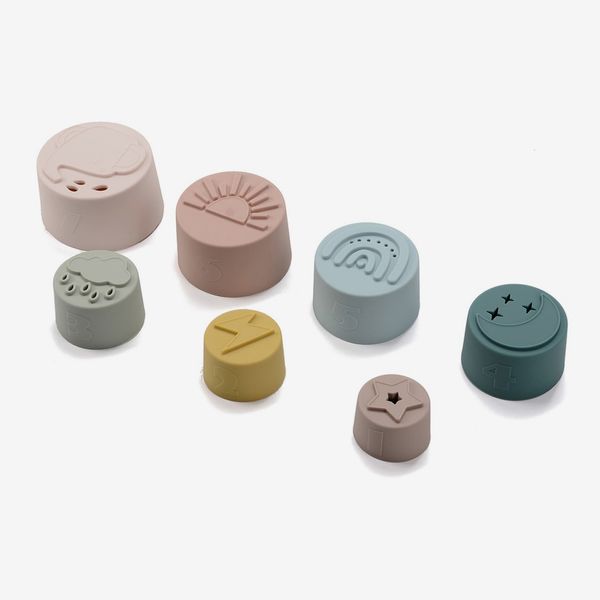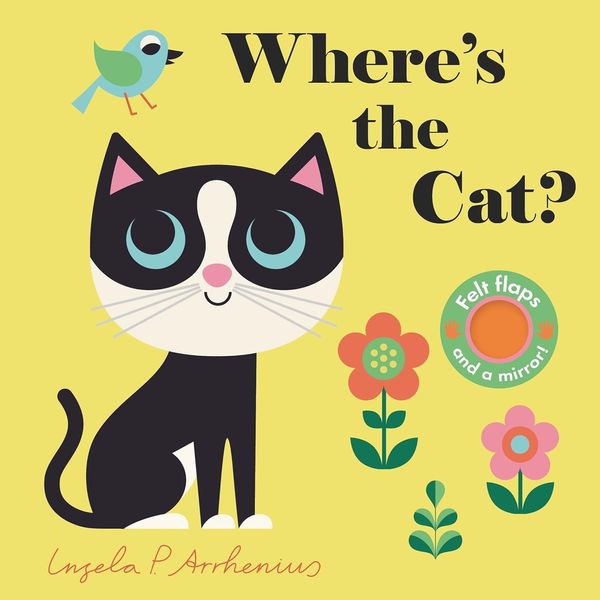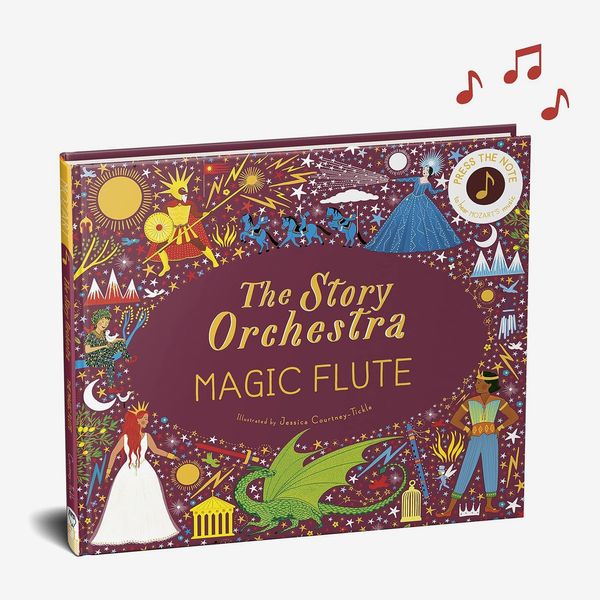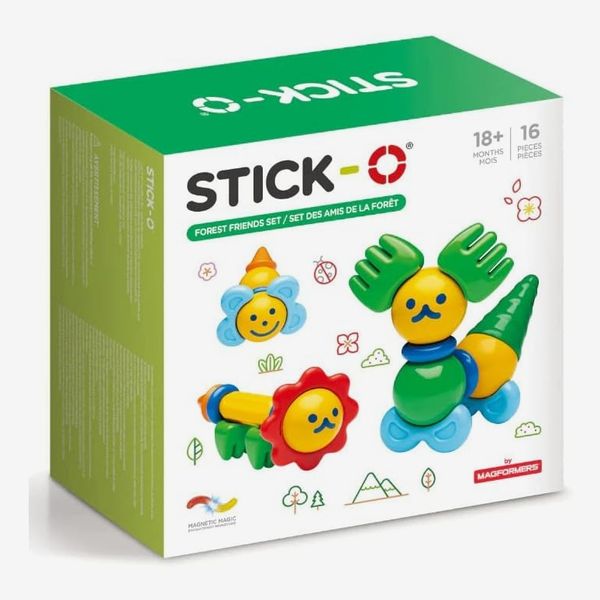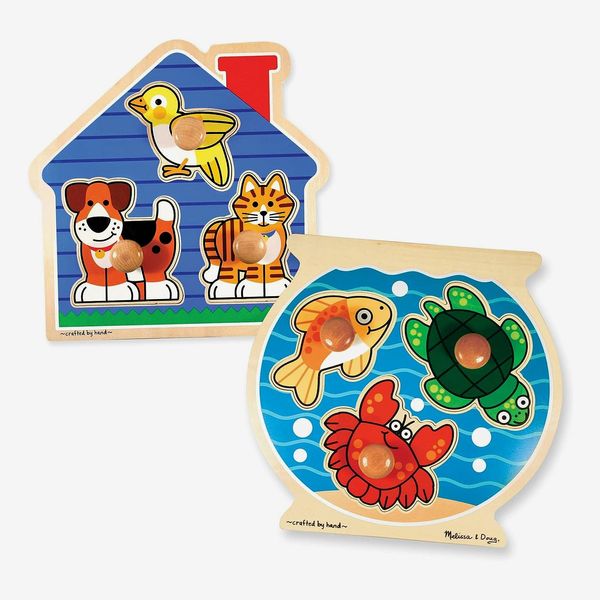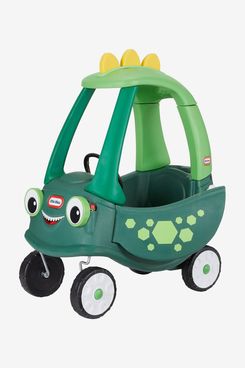
Jump to section
The key to delighting 1-year-olds is in finding toys that will stimulate and surprise their growing minds. “Babies’ brains develop so quickly — something like a million neural connections per second,” says Sarah MacLaughlin, a child-development expert and the author of What Not to Say: Tools for Talking With Young Children. “To keep them interested, you have to add sensory or mobility features to the mix.” So an engaging toy for a 1-year-old could be anything from a touch-and-feel book or a musical instrument to an interactive stuffed animal or a ride-on toy.
My son is almost 2 now, and over the course of the last year, his favorite toys have been the ones that let him practice new skills, from opening and closing a box and recognizing common objects in his life — animals, fruit, buses — to climbing, jumping, kicking, and learning to express himself with more complicated phrases. My favorite toys, meanwhile, have been the more open-ended ones that encourage him to play independently and look nice in our apartment. But as any small child would be, he is drawn to brightly colored plastic toys, a book we inherited that plays “The Farmer in the Dell” as sung by Elmo, and my phone. So I try to strike a manageable balance between what will make him giggle and what I can reasonably tolerate. And when buying gifts for other babies, I always take the parents’ taste into account, since they could end up playing with and staring at the gift I choose for years.
Keeping all this mind, I set out to find the best toys for 1-year-olds that will provide hours of fun while challenging their rapidly growing brains. All 37 of the thoroughly vetted gifts below have been a hit with the 1-year-olds or soon-to-be 1-year-olds in my life, including my son, or come recommended by teachers and arts educators, child-development professionals like MacLaughlin, cool parents, and toy experts.
To make it easy to stay within your budget, I’ve organized the list by price, so you can jump ahead or read all the way through to get a full picture of the best toys for 1-year-olds.
And if you’re also shopping for older kids, the Strategist has gift guides for 2-year-olds, 3-year-olds, 4-year-olds, 5-year-olds, 6-year-olds, 7-year-olds, 8-year-olds, 9-year-olds, 10-year-olds, 11-year-olds, and 12-year-olds — plus the meticulously curated Strategist Toy Store filled with all our greatest hits.
Update on December 15, 2024: Noted products that won’t arrive in time for Christmas; checked stock and updated prices on all products.
Under $25
Whether with fingerpaint, Play-Doh, or crayons, 1-year-olds love creating art— especially if they see big siblings drawing or painting. But most art supplies aren’t especially suitable for small, less-than-deft hands: Pencils have a dangerous point, paint makes a mess, and regular crayons snap into pieces. “Palm-grasp crayons are a great way to get young children to have interest in writing and drawing,” says Dr. Alexandra Figueras-Daniel, an assistant research professor at the National Institute for Early Education Research. “These are perfect for tiny hands to build fine-motor skills.” They’re almost impossible to break and washable, making it easy to just hand them over and let kids go to town. Even if the results just look like messy scribbling, this kind of exploration is key to laying the foundation for getting them to eventually write letters and numbers.
Babies (my son included) love these miniature board books with animal finger puppets attached. I found out about them from fellow Strategist writer Lauren Ro, who loved reading them to her two kids at this age. The books are small enough to fit in a diaper bag and the series features lots of different animals including a baby otter, sloth, llama, unicorn, and tiger.
At around 15 months, my son started to show an interest in feeding and serving pretend water or orange juice to his toys. So I gave him an tiny splattered enamelware mug, meant for a single shot of espresso, to encourage the inklings of pretend play. That cup is now one of his most prized possessions. He uses it to pour and scoop water in the bath or at his water table, and to mirror us drinking with an exaggerated and satisfied “ahhhhh.” We only have one little mug, but if I were giving a gift, I’d buy a set of two or four in different colors.
Though he hasn’t shown any special preference for any one stuffed animal, my son is obsessed with toy cars and trucks — especially this set of four friction-powered construction vehicles that Ro wrote about when her oldest son was 21 months old. They are perfectly sized for toddler hands, making it easy for him to hold onto one (and not let go) while we are strolling through the park or riding the subway. Because of the inner mechanism, very little effort or skill is needed to get them going and make them go really far — simply push one forward several times on the floor to build momentum before letting it go. He loves “driving” them around his playpen, at the playground, under my legs, and down makeshift ramps we construct out of board books or cardboard boxes. They are solid-feeling and have survived daily play for the past several months through sand, gravel, and the occasional puddle. Plus since they come in a four-pack, I was able to dole them out slowly between his birthday, Christmas, Hanukkah, and Easter.
Crawl tunnels are a thrill for this age group and get big laughs, to be sure, but they also help young toddlers with spatial awareness and a better understanding of object permanence. Older kids and adults know that the person whose face leans into and out of the tunnel is always nearby, but for a 1-year-old, these types of peekaboo games genuinely help them learn about how the world works. The pop-and-play tunnel offers six feet of play space, and collapses into a flat carrying case when it’s not in use. To expand the fun, you can even buy a two-pack.
According to mother of two Shirley Kim, who works as a clinical dietitian, these big colorful interlocking Mega Bloks are an amazing first building toy. “My kids played with them from age 1 all the way to age 8,” she says. The blocks’ bigger size makes them easy for small hands to grab and more appropriate for this age than, say, Lego Duplos (which happen to make an ideal gift for 2-year-olds). This set includes 80 pieces in all shapes and sizes that come packaged in a convenient storage bag.
Figueras-Daniel loves and recommends this bath toy because “it allows children to arrange and fill the tubes with water and observe the way to make the spinners go,” she says. This kind of observation teaches kids cause and effect, which helps develop cognitive skills. In this case, it also keeps them happy and engaged while in the bathtub.
These squishy textured nesting cups by Loulou Lollipop held my son’s attention for a surprisingly long time. They can be stacked to create a tower and stay that way thanks to embossed artwork on each cup’s bottom. And because they have small holes in the bottom they make great toys for water play. They’re BPA-free and made of 100 percent food-safe silicone, so they’re safe to use as a teething toy too.
I bought this submarine bath toy for my son’s first birthday. It’s now part of our nightly routine and helps distract when I’m washing his hair. The diver can be removed from the sub to swim free and the rear propellor spins when you push it through water.
This set of stickable foam bugs is another bathtime favorite. At first my son simply held and looked at them floating in the water. But now he’s figured out how to stick them to the side of the tub, to his belly, and, hilariously, to my forehead.
As a little kid I loved looking at books with special features like pull tabs, flaps, and pop-ups. And while they might appreciate the magic of a door you can open or a building that lifts off the page, a lot of 1-year-olds don’t have the finesse for such things. But this ingenious book, by author and illustrator Ingela P. Arrhenius, uses felt flaps instead of paper, making it much more well-suited to the littlest hands. It’s fun to watch my son proudly lift the colorful covers to reveal one of four animals and a mirror.
Some of my son’s favorite “toys” are actually books, like this one, that play sounds when you press a certain icon — a musical note in this case. Two of our current favorites are from a Gallimard Jeune series, albeit with text in French. But this unrelated title is in English and comes recommended by Ro: “My kids like pressing the buttons more than the story itself, honestly, but I like that they learn about classical music even if it’s in snippets. The illustrations are pretty, too, meaning the books make very nice gifts,” she says.
Children love emulating their caregivers: That’s why play kitchens, play lawnmowers, and ride-on cars are so popular. When Strategist contributor Steven John’s daughter was 1, she loved playing with her toy Dyson, just like her big brother before her. “If my wife or I grabbed our actual Dyson from the closet, she ran full-speed across the house to grab her own little vacuum and followed us around laughing as she ‘helped,’” he says. Not only does it look remarkably like the real thing, it has a motion-activated suction that can pick up little bits of paper, adding a dose of realism to playing make-believe.
Children love to play house, so why not get them their very own place? Eater restaurant editor Hillary Dixler Canavan recommends this low-commitment house made out of cardboard, and her 1.5-year-old daughter loves it, too, especially “sitting in there with books or opening and closing the window.” Inexpensive, customizable — it’s a blank canvas, after all — and perhaps best of all, sustainable, it’s a great option for city folks who don’t have access to a backyard. “It’s a commitment to have it in our living area, but it’s worth it for her to have a little imaginative play space,” she says — the house is about four feet tall. “And if we ever decide we just can’t take it anymore, we’ll recycle it.”
Artist Anna Bak-Kvapil loved playing with these silk scarves from Sarah’s Silks when her daughter was around 1. “The pure-silk nature of the scarves make them really soft and spectral,” she says, and they’re great for games of peekaboo. Strategist senior editor Jen Trolio notes that, while the silks are a great 1-year-old toy, they are another “grow-with-you” toy and very useful in pretend play. One of her own daughters wore a blue one for a couple of months straight as an Elsa cape when she was 3 years old.
[Editor’s note: These scarves will arrive a few days after Christmas.]
Under $50
When my son was 15 months old, I went to Japan for a wedding, leaving him at home with my husband. This magnetic building toy turned out to be my favorite souvenir, and my son’s favorite too, even though I didn’t realize until later that it’s also available to purchase online in the U.S. So it’s not the hard-to-find gem I thought it was, but that means I can easily buy more sets. What makes Stick-O stand out from other magnetic toddler toys are its sleek yet wacky designs — I bought this one because the “forest friends” animals reminded me of Pokémon and Miyazaki characters — and the satisfying sounds the pieces make when you click them together (or even just shake a single one).
All little children need a stuffed friend to cuddle with at night (and tote around tucked under an arm all day). “Let me apologize in advance for recommending this singing elephant,” says Fiorella Valdesolo, a writer, creative consultant, and mom. Tap one of its feet and the cuddly toy plays peekaboo; tap the other and it sings “Do Your Ears Hang Low” in what Valdesolo describes as “a creepy childish voice.” And yet “your baby will find it endlessly entertaining,” she says.
For kids who love music — and hitting things — this two-in-one toy ought to be, well, a hit. The multifunctional bench features a pullout xylophone and three wooden balls that can be banged on with a mallet. Once they’re pushed through, the balls either land on the xylophone to create a pleasing melody or simply roll down the ramp to be fetched. Remove the xylophone from the bench and you have a stand-alone musical instrument. Publicist and mother of two Sonya Li Casino says her now-3-year-old son loved it so much, “I ended up purchasing it for a few other 1-year-olds.”
The ever-popular “magic touch” piano from Baby Einstein lets children play classic tunes or create their own melodies with a gentle tap of the colored keys. As Dr. Sarah Roseberry Lytle, director of outreach and education at the Institute for Learning and Brain Sciences, explains, “Young kids love making music and noises and exploring things like, ‘Can I make it softer? Can I make it louder? What happens when I hit it harder? Does that make it louder?’ That’s a really interesting learning process.” The piano comes with a handful of color-coded song cards that babies and parents can play together.
They might look simplistic, but these jumbo knob puzzles from Melissa & Doug will keep toddlers busy for a shockingly long time. My son has an older version of this same type of puzzle from Melissa & Doug that he played with every single day at around 11 to 13 months old. The wooden knobs make the pieces easy for little hands to pick up, and the puzzle is pretty indestructible, too.
These curved wooden rainbow, waves, and fire blocks can often be found in Montessori and Waldorf classrooms alongside more basic rectangular versions. Each arc in the set can be stacked, balanced, and combined with the others to create imaginary scenes with bridges and buildings or to simply allow for experimenting with texture and gravity. “Stacking is fun, but even if they’re not coordinated enough to stack their toys, they would love to watch you stack and then be able to knock it down,” says MacLaughlin. This is also a classic “grow-with-me” toy that older kids can get surprisingly creative with — say, by pairing two pieces to form Skee-Ball rings, talking into one of the arcs as if it’s a phone, or building obstacle courses for dolls and toy cars.
Figueras-Daniel says that dolls with changeable clothes, like this one, provide opportunities for children to use fine-motor skills in fun ways. They also help with imaginative play that has a social element: “Toys that facilitate pretend play, like dress-up clothes, play phones, dolls, food, and dishes, allow children to start to carry out these play routines on their own and with others,” she says, adding that this kind of play ties in with language development too. Figueras-Daniel also recommends choosing dolls that come in various styles with different types of hair and skin tones, because it’s important for all children to see themselves, and the diversity of our world, reflected in the toys they play with. HABA’s soft 12-inch dolls have embroidered features, cute clothes, and are available in a dozen different styles including ones that depict toddler-age children and others that are more babyish.
Under $100
This innovative sensory board from Fat Brain Toys is one of my favorite recent toy launches; I am planning to buy it not only for my son but also as a gift for a couple of friends who are expecting. It’s basically a modular busy board that comes with magnetic tiles. Each one features a tactile activity of some sort, from switches and buttons to a spinning color wheel and a ball maze. You can switch the order of the tiles on the board or pack individual tiles in a diaper bag for play on the go. There are 12 tiles to choose from, (a starter bundle comes with the board and your choice of six tiles) and the activities vary in difficulty to keep children engaged for longer.
[Editor’s note: The PlayTab is currently sold out, but expected to be back in stock in January 2025.]
Strategist-favorite STEAM-kit maker Kiwico recently relaunched the Panda Crate, its subscription box for children up to 3 years old, and sent me a selection of the new toys to try out. But even more than the age-themed boxes we tried, this toy that can be purchased separately has captured my son’s attention. Most subscription toy services have a similar style of ramp that comes with little cars. But we like this one the best because the cars and wheels that come with it are incredibly eye-catching and can be used with the ramp or as stand-alone toys. The color-block design means they create optical illusions when they roll; my son uses them like toddler fidgets, staring at them for minutes on end as he makes them spin.
Like LEGO’s Duplo line, Playmobil Junior is designed for children who are fresh into toddlerhood. Most Duplo sets start their recommended age range at 18 months or 2 years old, whereas Playmobil Junior starts a little younger, at 12 months old. Functionally, this just means that the pieces are chunkier than conventional Playmobil pieces, don’t have any sharp edges, and don’t come with any small parts a toddler might choke on. But they have all the same slightly wacky, ultraspecific details you find in other Playmobil sets. And compared to Duplos, I prefer the way that Playmobil interprets Disney franchises while still holding on to the inherent Playmobil-ness of the toys. This Cinderella’s Castle set is both a pretend-play toy and a stacking toy in one. In the box you get Cinderella — whose skirt twists off to reveal pants! — Prince Charming, six stacking pieces, two stacking rattle pieces, the castle base with a slide, and four illustrated tokens that help tell the story: a glass slipper, a clock, a pumpkin carriage, and a trio of bluebirds.
“This wagon is great for the stage when your baby begins to ‘cruise’ or walk around the room by holding onto things,” says Zahra Kassam, founder of the at-home Montessori program Monti Kids. “It’s a Montessori-teacher favorite because it allows babies the opportunity to practice their walking skills while building their independence.” A tip she shared: “Weigh it down with heavy books or free weights to slow it down at first.”
“Blabla dolls are my go-to gifts for all the little people in my life,” says postpartum doula Julie Arvan, who invented the Nesting Days baby carrier. She adds that she starts giving them at age 1, telling us, “The dolls are more than toys. They’re whimsical companions for young children.” Arvan explains that transitional objects like these dolls “are key for gradually learning to separate from mother and explore the world.” I recently bought this cat in a sweater for my son as he was doing a lot of enthusiastic “meowing” around the apartment. The dolls are handmade in Peru from 100 percent cotton, and you can choose between two sizes: 18 inches or 12 inches. I prefer the larger size because it’s closer to matching the size of a toddler, making it easier to look in the eyes and more huggable.
[Editor’s note: We recommend selecting expedited shipping to guarantee the doll arrives in time for Christmas.]
This little car has been delighting kids for more than 40 years, and it’s surely got decades of popularity left. By the time they are about 18 months old, most toddlers will be able to “drive” it themselves — meaning use their feet to scoot it around. There’s nothing wrong with the classic red-and-yellow Cozy Coupe. But for something that’s going to take up a good amount of real estate, I prefer this lesser-known smiling green dinosaur or the ladybug. The smooth plastic exterior won’t mark or scratch most surfaces, so it’s suitable for use indoors; the plastic tires can handle brick and concrete, too.
$100 and up
We wrote about German toy brand Stapelstein’s lightweight stepping stones in last year’s holiday gift guide and included them on our list of the coolest, weirdest, and squishiest toys of 2023. I included the brand’s smaller nesting stones, called Inside, here when they first launched. But now I’m swapping those out for this mini rainbow set that’s more fun and versatile for younger kids. The new stones are half the size of the original-size stones and can be used almost exactly like their larger counterparts — stepped on, sat on, stacked, spun, used as a doll bed or bowl or drum, or just about anything else a kid can dream up. But they’re also small enough to be more easily used as play kitchen accessories or for color sorting other small toys. And like the Inside stones, they’re an ideal bath toy because they are waterproof and float. My son likes using them as little rafts for his Playmobil people and Schleich animals.
“My oldest would sit forever and try to work on these little locks when he was a toddler,” says Hawthorne about her now-teenage son. This lock box incorporates shape sorting and color matching in addition to different styles of locks. Though the age recommendation for this toy begins at 2 years old, many 1-year-olds will enjoy playing with it, especially after watching you model how it works. The buckling and unbuckling also allow them to exercise their developing fine-motor skills.
Ro swore by these kits — which contain a curated mix of developmentally appropriate toys and books — for her kids when they were as young as 1, and my own son has been playing with them since he was 3 or 4 months old. Ro says, “I was impressed with the quality, design, and thoughtfulness of each box, which came with in-depth instructions and suggestions for use as well as a breakdown of what you can expect your baby to do in that two-month span.” (There’s also an app with instructional videos and a chat space for parents.) One shipment might include a simple stacking toy; another might feature a soft baby doll. My son’s favorite kit to date is a set of faux keys that feel real since they’re made of stainless steel. While you can buy a lot of similar toys individually, the convenience factor is undeniable. And when you are done with each box the Lovevery brand name makes them easy to resell.
While this is definitely an investment, mom Jennifer Beall Saxton, the founder and CEO of Tot Squad, calls the Doona Trike the “most versatile tricycle ever” and promises that it’s something that can grow with a 1-year-old, with the recommended age range being 10 months to 3 years. “It’s the only ride-on toy that allows you to adjust each element, from who steers to who pedals or pushes, so that parents can relinquish some control at each stage of development,” she says. It starts off as a stroller with a partially enclosed seat and a handle for pushing, both of which can eventually be removed to leave just a trike in its most advanced mode. Says Saxton, “We got it just after my daughter turned 1 and had to steer and push for her, but as we spent time exploring our neighborhood she got more proficient, and now we can let her loose.” It also folds up for easy transport and storage.
Manhattan Toy is known for its astonishingly not-ugly wooden activity centers. And when my son got to play with this space-themed activity center at a fellow 1-year-old’s birthday party, he could not be pulled away. He was mesmerized by the beads, doors, and little space explorers that travel through tunnels on a track. My husband quickly declared that we needed to buy the same one, and I agreed. The quality and level of detail is incredible, and it’s sturdy enough to keep a wobbly baby upright. Best of all, it’s a toy I’d want to show off. My friends cleared away a lot of their baby’s toys for the party but left the activity center out right next to a tasteful moss-colored Brentwood Home play couch.
Greg Davidson, CEO and co-founder of baby brand Lalo bought a mini ball pit like this one for his son’s first birthday, and now both of his children love playing with it. “It’s a toy that has lasted us forever,” he says. While it’s more expensive than a lot of other ball pits, this one has a machine-washable cover and comes with BPA-free plastic balls.
Additional reporting by Lauren Ro and Steven John.
The Strategist is designed to surface the most useful, expert recommendations for things to buy across the vast e-commerce landscape. Some of our latest conquests include the best acne treatments, rolling luggage, pillows for side sleepers, natural anxiety remedies, and bath towels. We update links when possible, but note that deals can expire and all prices are subject to change.
Every editorial product is independently selected. If you buy something through our links, New York may earn an affiliate commission.











